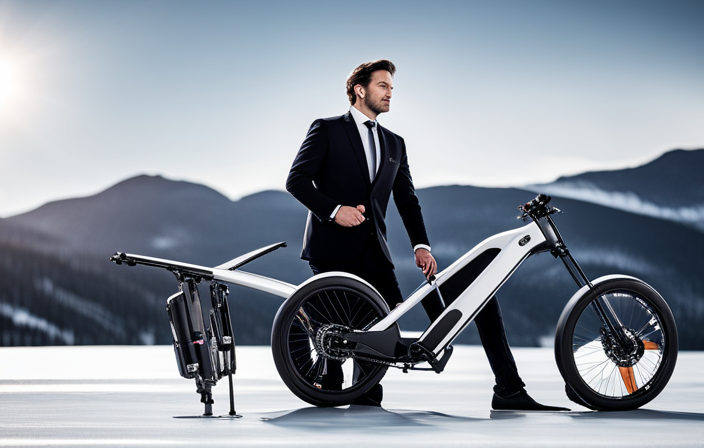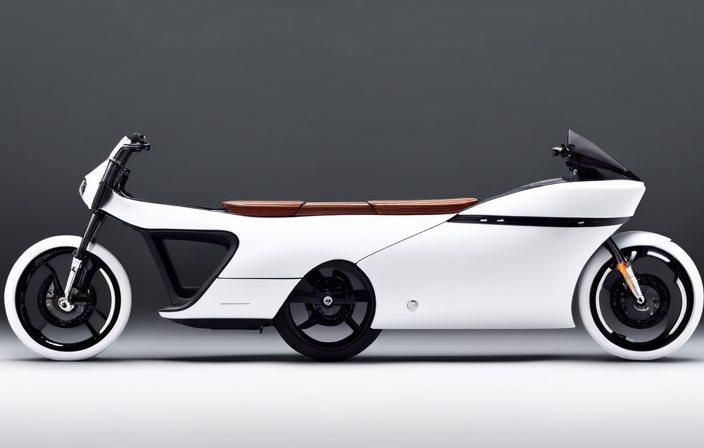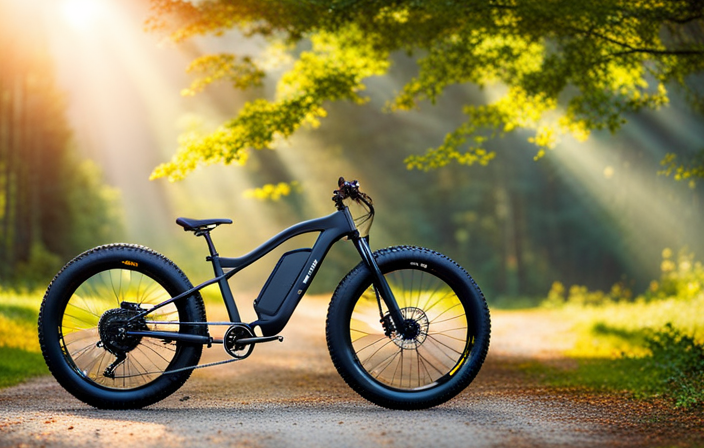As an avid electric bike enthusiast, I have often found myself contemplating the price of a replacement battery. It’s a question that looms over every rider’s mind as we seek to keep our trusty steeds powered and ready for the road.
In this article, we will explore the factors that influence the cost of an electric bike battery, from the type and capacity to brand reputation and compatibility. So, let’s dive in and uncover the secrets behind the price tag of this vital component.
Key Takeaways
- Lithium-ion batteries are more expensive but have higher energy density and performance compared to lead-acid batteries.
- Investing in a reputable brand ensures battery longevity and reliability.
- Consider the compatibility of the battery with the electric bike model, including voltage requirement and physical dimensions.
- Follow manufacturer’s charging guidelines, avoid extreme temperatures, and regularly maintain the battery to extend its lifespan.
Battery Type: Lithium-ion vs. Lead-acid
Lithium-ion batteries are more expensive than lead-acid batteries for electric bikes. This price difference can be attributed to several factors.
Firstly, lithium-ion batteries utilize advanced technology, which makes them more costly to produce. Additionally, lithium-ion batteries have a higher energy density, meaning they can store more energy in a smaller and lighter package. This increased energy density contributes to their higher performance compared to lead-acid batteries.
In terms of battery cost, lithium-ion batteries are generally priced higher due to their superior performance and longevity. While lead-acid batteries may have a lower upfront cost, they tend to have a shorter lifespan and lower cycle life compared to lithium-ion batteries. This means that over time, the cost of repeatedly replacing lead-acid batteries can exceed the initial investment in a lithium-ion battery.
Furthermore, lithium-ion batteries offer other advantages over lead-acid batteries. They have a higher charge/discharge efficiency, allowing for better energy utilization. They also have a lower self-discharge rate, meaning they can retain their charge for longer periods without needing to be recharged. These factors contribute to the overall superior performance of lithium-ion batteries.
Moving on to the next section about battery capacity: voltage and ampere-hours, it is important to understand how these factors impact the overall performance and range of an electric bike.
Battery Capacity: Voltage and Ampere-hours
You’ll want to consider the voltage and ampere-hours when choosing a battery for your e-bike. The voltage indicates the strength of the electrical current that the battery can provide, while the ampere-hours represent the capacity or endurance of the battery.
To determine the ideal battery capacity, you need to consider your riding habits and the distance you plan to travel. A higher voltage will provide more power to your e-bike, resulting in better acceleration and performance. However, a higher voltage also means a shorter battery lifespan.
On the other hand, having a battery with a higher ampere-hour rating will give you a longer range but may sacrifice some power. It’s crucial to strike a balance between voltage and ampere-hours to find the right battery capacity for your needs.
Additionally, charging efficiency is another important factor to consider. Some batteries have better charging efficiency, which means they can be charged faster and more efficiently. This can significantly impact your overall riding experience and convenience.
When selecting a battery, it’s vital to consider both the battery lifespan and charging efficiency to ensure you get the most out of your e-bike.
Now, let’s move on to the next section, where we will discuss the importance of brand reputation and quality in choosing the right battery for your e-bike.
Brand Reputation and Quality
When it comes to choosing a battery for your e-bike, it’s important to consider the reputation and quality of the brand. A battery is the heart of your electric bike, providing the power necessary for your rides. Opting for a reputable brand ensures that you’ll have a reliable and long-lasting battery.
To help you understand the significance of brand reputation and quality, let’s take a look at a comparison table showcasing the battery longevity of two popular e-bike battery brands:
| Brand | Battery Longevity (in years) |
|---|---|
| Brand A | 3 |
| Brand B | 5 |
| Brand C | 4 |
| Brand D | 2 |
As you can see, the difference in brand reputation can have a significant impact on battery longevity. Investing in a brand with a proven track record of quality can save you from the hassle and expense of premature battery replacements.
Now that we understand the importance of brand reputation and quality, let’s delve into the next aspect of choosing an e-bike battery: warranty and customer support.
Warranty and Customer Support
Opting for a reputable brand ensures that you’ll have reliable customer support and a warranty for your e-bike. When purchasing an electric bike, it is essential to consider the level of customer satisfaction and warranty coverage provided by the brand. This not only ensures peace of mind but also guarantees that any issues or concerns you may encounter will be addressed promptly.
Customer satisfaction is a crucial aspect of any purchasing decision. Reputable brands prioritize their customers’ needs and strive to provide exceptional support. Whether it’s answering questions about your e-bike’s features or resolving technical difficulties, reliable customer support is there to assist you every step of the way.
Additionally, a warranty is an important consideration when investing in an electric bike. It offers a level of protection against manufacturing defects and unexpected failures. A comprehensive warranty coverage can provide peace of mind, knowing that any potential issues with your e-bike will be addressed and resolved without significant financial burden on your part.
Considering customer satisfaction and warranty coverage can save you from potential headaches down the road. Now, let’s delve into the next section, which focuses on the compatibility of the battery with your electric bike model.
Compatibility with Your Electric Bike Model
To ensure compatibility with your e-bike model, it’s important to consider the specifications of the battery. Electric bike battery compatibility is crucial in finding the right battery for your electric bike. Each e-bike model has specific requirements for the battery, including voltage, capacity, and physical dimensions. Before purchasing a battery, it is essential to consult your e-bike’s user manual or contact the manufacturer to determine the exact specifications needed.
The first step in determining battery compatibility is to check the voltage requirement of your electric bike. Most e-bikes operate on either 36V or 48V systems, although there are exceptions. Using a battery with a different voltage can lead to compatibility issues and potentially damage your e-bike’s electrical system.
Capacity is another important factor to consider. It refers to the amount of energy the battery can store and is usually measured in ampere-hours (Ah). The higher the capacity, the longer the battery will last between charges. It’s essential to choose a battery with sufficient capacity to meet your riding needs.
Lastly, the physical dimensions of the battery must match your e-bike’s battery compartment. Different e-bike models have varying sizes and shapes of battery compartments, so it’s crucial to select a battery that fits properly.
Considering these specifications will ensure that the battery you choose is compatible with your electric bike, providing optimal performance and longevity.
Now, let’s delve into the next topic: charging time and efficiency.
Charging Time and Efficiency
The charging time and efficiency of an e-bike battery can vary depending on factors such as the charger used and the battery’s state of charge. A higher power charger will generally charge the battery faster, but it’s important to note that charging too quickly can potentially reduce the battery’s overall lifespan. Therefore, it’s recommended to use a charger that matches the manufacturer’s specifications for optimal performance and longevity.
Another factor to consider is the battery’s energy consumption during the charging process. Different batteries have varying levels of energy efficiency, meaning some may require more electricity to fully charge compared to others. This can impact the overall cost of charging an e-bike battery over time.
To ensure maximum efficiency, it’s essential to monitor the battery’s state of charge during the charging process. Avoid overcharging the battery, as it can lead to decreased performance and potential damage. It’s also advisable to charge the battery in a cool environment, as higher temperatures can negatively affect the charging efficiency.
Now, let’s delve into the next section about the range and performance of an e-bike, exploring the factors that can influence these aspects without skipping a beat.
Range and Performance
After discussing the charging time and efficiency of electric bike batteries, it is crucial to delve into the range and performance aspect. This will give us a better understanding of how far an electric bike can go on a single charge and how well it performs during the ride.
-
Battery Range: The range of an electric bike battery refers to the distance it can travel on a single charge. This depends on various factors such as the battery capacity, terrain, rider weight, and assist mode. Higher capacity batteries generally offer a longer range, allowing riders to go further without needing to recharge.
-
Battery Performance: Battery performance encompasses several aspects, including power output, efficiency, and durability. A high-performance battery delivers ample power to the electric motor, resulting in better acceleration and speed. Efficiency is crucial to maximize the range and make the most of the battery’s capacity. Additionally, a durable battery can withstand the rigors of regular use and maintain its performance over time.
-
Factors Affecting Battery Range and Performance: Several factors can influence battery range and performance. These include the level of assist used, riding style, terrain, and temperature. Riding in hilly areas or using higher assist levels can decrease the range, while riding on flat terrain with lower assist levels can extend it. Extreme temperatures, especially cold weather, can also affect battery performance.
-
Battery Management Systems: To optimize battery range and performance, modern electric bike batteries are equipped with sophisticated battery management systems (BMS). The BMS monitors and regulates battery voltage, temperature, and charging cycles to ensure optimal performance and longevity. It also provides important data to the rider, such as battery level and estimated range.
Transitioning into the subsequent section about the weight and size of the battery, we can explore how these factors impact the overall usability of an electric bike.
Weight and Size of the Battery
When considering a battery for your electric bike, you’ll want to take into account the weight and size. These factors can greatly impact the overall performance and handling of your bike. In recent years, battery technology advancements have made it possible to have lighter and smaller batteries without compromising on power and range.
Cost and affordability are also important considerations when choosing a battery. As technology has improved, the cost of electric bike batteries has decreased, making them more accessible to a wider range of consumers. Additionally, advancements in battery technology have increased the lifespan of batteries, reducing the need for frequent replacements and ultimately saving you money in the long run.
Battery weight and size can have a significant impact on the overall riding experience. A lighter battery will make your bike easier to handle and maneuver, especially when navigating tight corners or steep inclines. Smaller batteries also allow for greater flexibility in terms of design and placement on your bike.
In conclusion, when considering a battery for your electric bike, it’s important to take into account the weight and size, as well as the cost and affordability. Battery technology advancements have made it possible to have lighter and smaller batteries without compromising on power and range. This not only improves the overall riding experience but also makes electric bikes more accessible and affordable for a wider range of consumers.
Now, let’s explore the next section about the availability and accessibility of electric bike batteries.
Availability and Accessibility
To find a battery for your e-bike, you’ll need to consider its availability and accessibility in your local area. Here are four key factors to keep in mind when assessing battery options:
-
Brand and Model: It’s essential to research reputable brands and models known for their reliable batteries. Look for manufacturers with a strong track record in producing high-quality e-bike batteries.
-
Compatibility: Ensure that the battery you choose is compatible with your specific e-bike model. Different manufacturers may have different battery requirements, so double-check the specifications before making a purchase.
-
Local Retailers: Check if there are local retailers or bike shops in your area that stock e-bike batteries. Having a nearby source for replacements or repairs can be beneficial, as it saves you from relying solely on online purchases or shipping.
-
Online Availability: Explore online marketplaces and specialized e-commerce platforms that offer a wide range of e-bike batteries. Check customer reviews and ratings to ensure the reliability of the seller.
Considering battery availability and accessibility is crucial in ensuring that you can easily find and replace your e-bike battery when needed. Once you have identified suitable battery options, you can explore government incentives and subsidies that may further offset the cost of your e-bike battery.
Government Incentives and Subsidies
Government incentives and subsidies can help offset the cost of your e-bike battery, making it more affordable for you. When considering the cost of an electric bike battery, it’s important to conduct a thorough cost analysis to determine the most cost-effective option.
Many governments around the world have recognized the benefits of promoting electric transportation and have implemented various incentives and subsidies to encourage their adoption. These government incentives can come in the form of tax credits, grants, or rebates, which can significantly reduce the upfront cost of purchasing an e-bike battery. Additionally, some regions offer subsidies specifically for electric bike batteries, further lowering the cost for consumers. It is worth researching the specific incentives available in your area to take full advantage of any financial assistance that may be available.
By taking advantage of government incentives and subsidies, the overall cost of your e-bike battery can be reduced, making it more affordable for you to enjoy the benefits of electric transportation.
Transitioning into the subsequent section about battery lifespan and longevity, understanding the cost of a battery is not just about the upfront expense, but also about the long-term value and performance.
Battery Lifespan and Longevity
Understanding how long your e-bike battery will last and how to extend its lifespan is crucial for maximizing your investment. As an e-bike enthusiast, I have learned valuable insights into battery longevity and the factors that affect it. Here are three key points to consider:
-
Battery charging methods: It is essential to follow the manufacturer’s guidelines for charging your e-bike battery. Overcharging or undercharging can have a detrimental effect on its lifespan. Using the recommended charger and avoiding fast-charging methods will help maintain the battery’s health.
-
Impact of temperature on battery lifespan: Temperature plays a significant role in determining the lifespan of your e-bike battery. Extreme heat or cold can lead to accelerated degradation. It is advisable to store and charge your battery in a moderate temperature environment to minimize the impact on its longevity.
-
Proper battery maintenance: Regular maintenance is crucial for extending the life of your e-bike battery. This includes keeping it clean, avoiding excessive moisture exposure, and periodically checking for any signs of damage or wear.
By understanding these factors and implementing proper battery care, you can ensure that your e-bike battery lasts as long as possible.
Now, let’s delve into the next section, where we will explore the recycling and environmental impact of e-bike batteries.
Recycling and Environmental Impact
Recycling and properly disposing of e-bike batteries is crucial for minimizing their environmental impact. Battery disposal is an important aspect of the life cycle of an electric bike, as it directly affects the sustainability of the technology and the impact on natural resources.
E-bike batteries, like any other rechargeable battery, contain hazardous materials such as lead, lithium, and cadmium. When not disposed of properly, these materials can leach into the soil and water, causing pollution and harming ecosystems. To mitigate this, it is essential to recycle e-bike batteries at the end of their life span.
The recycling process involves extracting valuable materials from the batteries, such as lithium, cobalt, and nickel. These materials can then be reused in the production of new batteries or other products. By recycling e-bike batteries, we can reduce the demand for extracting raw materials, which in turn reduces the impact on natural resources.
In addition to recycling, it is also important to dispose of e-bike batteries in designated collection centers or through authorized recycling programs. This ensures that the batteries are handled and treated properly, minimizing the risk of environmental contamination.
Transitioning into the subsequent section about the cost of replacement parts and accessories, it is crucial to note that proper battery disposal is not only beneficial for the environment but also for the overall sustainability and longevity of an electric bike.
Cost of Replacement Parts and Accessories
The cost of replacing parts and accessories for an e-bike can vary depending on the brand and model. When it comes to obtaining replacement parts for an electric bike, it is important to consider not only the cost of the actual part but also the additional expenses such as shipping and installation. These factors can significantly impact the overall cost of maintaining and repairing your e-bike.
The cost of shipping is something to take into account when purchasing replacement parts for an electric bike. Depending on where you live and where the parts are being shipped from, the cost of shipping can vary. It is advisable to check with the seller or manufacturer about their shipping policies and costs before making a purchase. This will help you avoid any unexpected expenses and ensure that the replacement parts are delivered to you in a timely manner.
In addition to the cost of shipping, the cost of installation should also be considered. While some replacement parts and accessories can be easily installed by the bike owner, others may require professional assistance. If you’re not comfortable or experienced with bike repairs, it’s recommended to have a professional handle the installation process. However, keep in mind that this will incur an additional cost.
Considering the cost of shipping and installation, it is important to factor in these expenses when budgeting for replacement parts and accessories for your e-bike. Proper planning can help you avoid any financial surprises and ensure that your electric bike remains in optimal condition.
Transitioning to the subsequent section about maintenance and upkeep costs, it is essential to understand that maintaining an e-bike involves more than just replacing parts and accessories. It also requires regular maintenance and upkeep to ensure its longevity and performance.
Maintenance and Upkeep Costs
Transitioning to the subsequent section about maintenance and upkeep costs, it’s important to note that regular maintenance is necessary to keep your e-bike in optimal condition. Proper maintenance not only extends the lifespan of your electric bike but also ensures its performance and safety. Here are three key aspects to consider when it comes to the cost of regular maintenance and the importance of proper storage:
-
Routine Check-ups: Just like any other vehicle, e-bikes require regular check-ups to identify and address any potential issues. This includes inspecting the battery, brakes, tires, and other components to ensure they are functioning properly. Regular check-ups can help prevent costly repairs down the line.
-
Cleaning and Lubrication: Keeping your e-bike clean and well-lubricated is essential for its longevity and smooth operation. Regularly cleaning the frame, wheels, and drivetrain helps prevent dirt and grime buildup, which can lead to premature wear and tear. Additionally, applying lubricant to the chain and other moving parts reduces friction and ensures proper functioning.
-
Proper Storage: Storing your e-bike correctly is crucial to protect it from the elements and prevent damage. Ideally, you should store it in a dry and secure location, away from extreme temperatures and direct sunlight. Using a bike cover or storing it indoors can help protect it from dust, moisture, and potential theft.
By prioritizing regular maintenance and proper storage, you can minimize the cost of repairs and ensure that your e-bike remains in excellent condition.
Now, let’s delve into the next section, where we will compare prices from different retailers and online platforms.
Comparison of Prices from Different Retailers and Online Platforms
When shopping for an e-bike, you’ll find that prices can vary significantly between different retailers and online platforms. This is especially true when it comes to the price of batteries, an essential component of electric bikes. Conducting a battery price comparison is crucial to ensure you get the best deal and value for your money.
To begin your battery price comparison, start by researching different retailers and online platforms that sell e-bike batteries. Look for reputable sellers with positive consumer reviews and a track record of providing quality products. Reading consumer reviews can give you valuable insights into the performance and reliability of the batteries offered by different sellers.
Once you have identified several potential sellers, compare the prices of their batteries. Keep in mind that the cost of batteries can vary based on factors such as capacity, brand, and technology. Higher capacity batteries or those from well-known brands may be more expensive. However, it’s essential to consider the long-term benefits and durability of the battery when making your decision.
In addition to price, also consider the warranty offered by different sellers. A longer warranty period can provide peace of mind and indicate the seller’s confidence in the quality of their batteries.
Frequently Asked Questions
How do lithium-ion batteries compare to lead-acid batteries in terms of performance and lifespan?
Lithium-ion batteries are more environmentally friendly and commonly used in electric bikes. They outperform lead-acid batteries in terms of performance and lifespan. Their lightweight design and higher energy density make them the preferred choice for electric bike manufacturers.
Are there any government incentives or subsidies available for purchasing an electric bike battery?
Unfortunately, government incentives and subsidies for electric bike batteries are not as common as one would hope. However, it is important to understand the impact of government policies on the electric bike battery market.
What is the average lifespan of an electric bike battery and how can I maximize its longevity?
To maximize the lifespan of an electric bike battery, it’s crucial to follow charging best practices. This includes avoiding overcharging, maintaining an optimal charging level, and storing the battery in a cool, dry place.
What are the maintenance and upkeep costs associated with owning an electric bike battery?
The maintenance costs for owning an electric bike battery include regular charging, which is recommended every 2-3 days. Additionally, periodic inspections for wear and tear and cleaning of the battery terminals are necessary for optimal performance and longevity.
Can you provide a comparison of prices for electric bike batteries from different retailers and online platforms?
Comparing prices for electric bike batteries across various retailers and online platforms reveals significant variation. Retailer X offers the most competitive price, while online platform Y offers a wider selection but at higher prices.
Conclusion
In conclusion, after delving into the intricacies of electric bike batteries, it is evident that their cost varies based on several factors.
The type of battery, such as lithium-ion or lead-acid, affects pricing significantly. Additionally, battery capacity, brand reputation, warranty, and compatibility with your bike model all play a role.
Considering the environmental impact, recycling options, and the cost of replacement parts and maintenance, it becomes clear that investing in a high-quality battery is crucial.
As the saying goes, ‘You get what you pay for,’ so choose wisely and prioritize long-term efficiency and reliability.
















